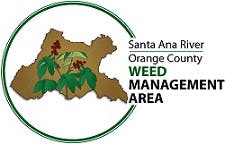Invasive Plants
Control of Invasive Species
The RCRCD works to remove and control invasive plants from all of their conservation easements and fee title lands. Management of invasive species is done through a variety of techniques which include hand weeding, cut and stump treatment and herbicide applications when necessary. Herbicide applications are done by trained and licensed applicators. Along with state and local partners, the RCRCD continuously monitors for new and emergent invasive species and stays up to date on current control methods.

These are just a few of the dozens of invasive plants that are being targeted for removal within the District service area.
- Giant reed (Arundo donax)
- Castor bean (Ricinus communis)
- Stinknet (Oncosiphon piluliferum)
- Sahara Mustard (Brassica tournefortii)
- Salt Cedar (Tamarix ramosissima)
- Russian Thistle (Salsola tragus)
- Mustard species
Due to the aggressive nature of these exotic, non-native plants, eradication takes many years, with some plants requiring as much as 10 years of control efforts. Integrated pest management (IPM) is also being used to control some species. IPM uses a mixture of chemical, mechanical, and biological controls to manage pest plants. This helps reduce the dependence on chemicals alone, and gives the management agencies and contractors better ability to control costs.

A 20 year control plan for the Santa Ana River Watershed is in place for the management of Giant Reed (Arundo donax). The extensive plan includes cooperation with other Conservation Districts through the Santa Ana Watershed Association (SAWA). Each District works within its boundaries to control Giant Reed along upstream tributaries and the Santa Ana River main stem. Currently, there is a movement to draft a plan for management of the very invasive perennial pepperweed.



.png?ixlib=rb-1.1.0&or=0&w=720&h=720&fit=max&auto=format%2Ccompress&s=67caba4c68608c8a9df81daeb96f6208)
